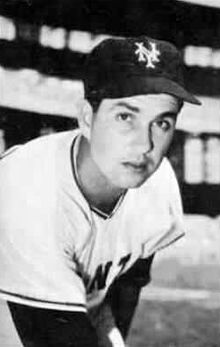Hoyt Wilhelm
| Hoyt Wilhelm | |||
|---|---|---|---|
 |
|||
| Pitcher | |||
|
Born: July 26, 1922 Huntersville, North Carolina |
|||
|
Died: August 23, 2002 (aged 80) Sarasota, Florida |
|||
|
|||
| MLB debut | |||
| April 18, 1952, for the New York Giants | |||
| Last MLB appearance | |||
| July 10, 1972, for the Los Angeles Dodgers | |||
| MLB statistics | |||
| Win–loss record | 143–122 | ||
| Earned run average | 2.52 | ||
| Strikeouts | 1,610 | ||
| Saves | 228 | ||
| Teams | |||
| Career highlights and awards | |||
|
|||
| Member of the National | |||
|
|
|||
| Inducted | 1985 | ||
| Vote | 83.8% (eighth ballot) | ||
James Hoyt Wilhelm (July 26, 1922 – August 23, 2002), nicknamed "Old Sarge", was an American Major League Baseball pitcher with the New York Giants, St. Louis Cardinals, Cleveland Indians, Baltimore Orioles, Chicago White Sox, California Angels, Atlanta Braves, Chicago Cubs, and Los Angeles Dodgers between 1952 and 1972. Wilhelm was elected to the Baseball Hall of Fame in 1985, and is one of 78 pitchers enshrined in the Hall.
Wilhelm grew up in North Carolina, fought in World War II, and then spent several years in the minor leagues before starting his major league career at the age of 29. He was best known for his knuckleball, which enabled him to have great longevity. He appeared occasionally as a starting pitcher, but pitched mainly as a reliever. Wilhelm won 124 games, still the record for relief pitchers. He was the first pitcher to reach 200 saves, and the first to appear in 1,000 games.
Wilhelm was nearly 30 years old when he entered the major leagues, and pitched until he was nearly 50. He retired with one of the lowest career earned run averages, 2.52, in baseball history. After retiring as a player in 1972 Wilhelm held longtime coaching jobs with the New York Yankees and Atlanta Braves. He lived in Sarasota, Florida for many years, and died there in 2002.
Wilhelm was one of eleven children born to poor tenant farmers John and Ethel (née Stanley) Wilhelm in Huntersville, North Carolina. He played baseball at Cornelius High School in Cornelius, North Carolina. There, he began experimenting with a knuckleball after reading about pitcher Dutch Leonard. He felt that, because he could not throw fast, honing a knuckleball offered him his best shot at success. He used a tennis ball to practice.
...
Wikipedia
